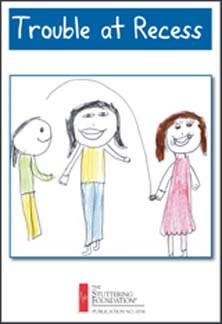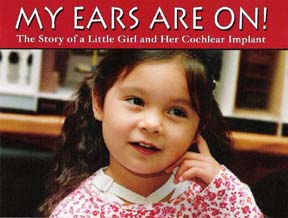Helping Children Tell Their Own Story
 |
About the presenter: Julie G. Gasway MA/CCC-SLP is a graduate of the University of Iowa (BA 1982, and MA 1984). Her first stuttering mentor was Dr. Dean Williams. She worked at a hospital for 20 years, and 4 years ago she started a private practice. Her case load includes patients with articulation, language and stuttering impairments. She has a special interest in stuttering therapy. She and her mentors Patricia Zebrowski Ph.D/CCC and Toni Cilek MA/CCC facilitate an adult support group for people who stutter. Julie is presently pursuing her Board Recognition in Fluency Disorders. |
 |
About the presenter: MaryAnn S. Simpson, M.A., CCC-SLP lives and works in Ithaca, NY where she is currently employed by the Ithaca City School District, Early Childhood Education Program. She received her undergraduate degree from SUNY Geneseo in 1978 and her graduate degree from Bowling Green State University of Ohio in 1979. She has worked in many different clinical settings including preschools, public school, specialized programs for students with autism, hospitals, private practice and as a Clinical Instructor/Supervisor at Ithaca College. She is the author of My Ears Are On which is a true story and was written in 2007. |
This article is co-authored by two speech-language pathologists who found that an excellent way for children's stories to be told is writing a book. One of the stories was written with a child who stutters, the other features a child who is deaf and has a cochlear implant. Although both stories are currently commercially available at a very reasonable cost, the story of how these stories were developed can serve as a model and inspiration to help other children tell they story. J. Kuster
Helping Children Tell Their Own Story
by Julie Gasway, from Iowa, USA and MaryAnn Simpson, from New York, USA
Julie Gasway: While working with a 7 year old girl, I noticed that she was becoming more aware of her stuttering but was unable to talk about it. Since she had a strong interest in art, I thought drawing might be a way to communicate that would not provoke anxiety. Initially she drew pictures of all the things she enjoyed. I wanted her to feel positive about herself and about stuttering. While drawing she was able to use self talk and identify her own feelings, beliefs and behaviors. Eventually she began to talk about things that could happen if she stuttered in public.
We were able to practice role playing of appropriate ways to interact and deal with peers, friends, teachers and family. During this time we also researched stuttering, building up her own treasure chest of information about stuttering. During one session the topic of teasing came up and she began to think about what she would do if she were ever teased. Initially she wanted to write a story about a child who was teased about wearing hearing aides, but soon the focus became a little girl who stuttered and was teased. She did not recall ever being teased, but the thought of it was frightening to her. She drew and talked about what her options might be, (telling the school principal and the teaser being "kicked out of school FOREVER," changing schools and more....).
 We worked on her story, which became the book Trouble At Recess, over a period of months. Some days she wanted to work on other stuttering goals. She did not want to take her book or pictures home to work on them outside of therapy. We talked about what makes up a story (people, place, plot, conclusion etc.) and she dictated the script for each picture. I kept the words in the text her own, but occasionally asked her questions to see where she wanted the plot to go next. When the book was finished we shared this with her family and they had a chance to talk about teasing, and how she felt about stuttering.
We worked on her story, which became the book Trouble At Recess, over a period of months. Some days she wanted to work on other stuttering goals. She did not want to take her book or pictures home to work on them outside of therapy. We talked about what makes up a story (people, place, plot, conclusion etc.) and she dictated the script for each picture. I kept the words in the text her own, but occasionally asked her questions to see where she wanted the plot to go next. When the book was finished we shared this with her family and they had a chance to talk about teasing, and how she felt about stuttering.
Later the book was published by the Stuttering Foundation of America. (It can be ordered from the Stuttering Foundation - www.stutteringhelp.org for $5 or downloaded free at http://www.stutteringhelp.org/Portals/English/book0034.pdf). This little girl and her parents bought many copies of the book and had a book signing for her friends at the local library. Additionally they took donations and bought a book for every elementary school in our city. The whole process; writing a script, drawing the pictures,learning about stuttering, and sharing her work was a positive experience for me as a therapist and for her and her family. She has also received many letters from people telling her how informative and helpful her book has been. Hopefully this experience will contribute to her positive self image!
MaryAnn Simpson: My Ears Are On! is a soft cover picture book for young children about a little girl who was born deaf, but now can hear because of the amazing technology of a cochlear implant (website: myearsareon.com). It was created when working with a child with a cochlear implant and discovering that there were no children's books on the topic. The child's classmates and staff at  her school were curious about the visible implant and the many specialists who visited her classroom each day to support her educational program. Using a story with actual photos seemed a logical way to address this need.
her school were curious about the visible implant and the many specialists who visited her classroom each day to support her educational program. Using a story with actual photos seemed a logical way to address this need.
The original book was created using the online technology of iPhoto, an online software application developed by Apple that allows users to manage their digital photos. One of the options users have is to create personalized books that are then professionally printed by the online service and assembled into either a soft-cover or hard-cover edition for a reasonable price (http://www.apple.com/ilife/iphoto/printproducts.html). The program offers pre-designed "themes" if desired or can be fully customized. Books come standard with 10 double-sided pages (20 page books) but additional pages are also possible. User friendly tools are provided to help even the novice create amazing results. It is a simple "drag and drop" procedure for inserting your digital photos into pre-designed templates with editing tools that allow you to insert text and customize as you wish. Multiple backgrounds, fonts, and "themes" are among the many options. If you don't have digital photos, you can simply scan in your photos. Other online systems are also available such as picaboo.com and snapfish.com that provide similar services.
The finished product was well received by the child, the students in her preschool and by all who read it in her community of friends and family. Not only was the book important for the child's classmates - helping them to understand the amazing technology and to support their friend - but it was an important step towards self-advocacy for this four year old. She is now a confident first grader and proudly talks about her "CI" with ease.
There are many applications in clinical or educational settings for creating personalized books about individuals with disabilities; informational, autobiographical, or story format. Consider trying the iPhoto system or another similar online system for creating your own book.
submitted July 30, 2008

